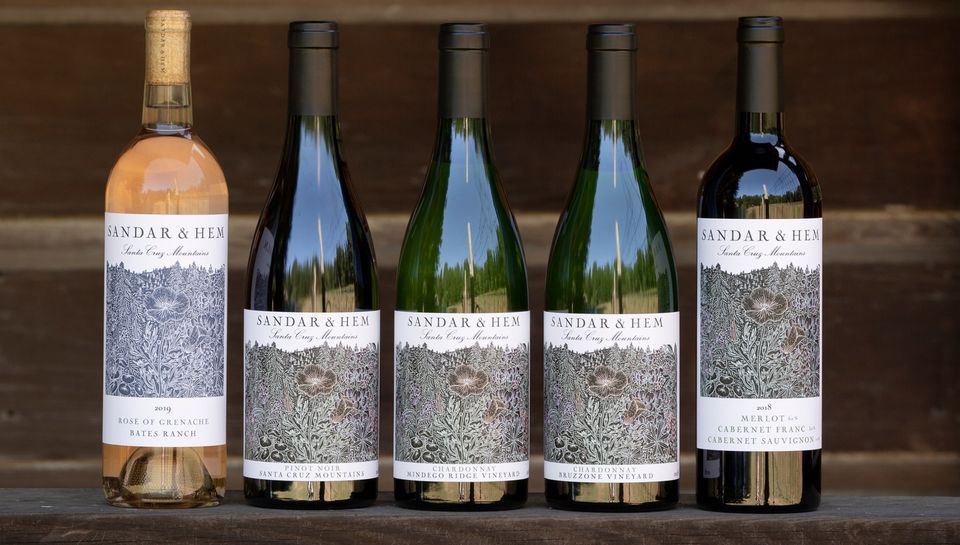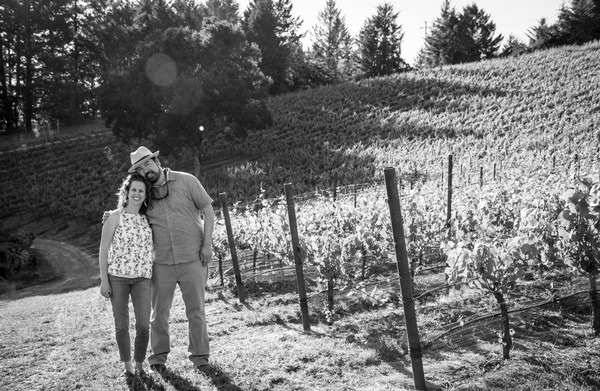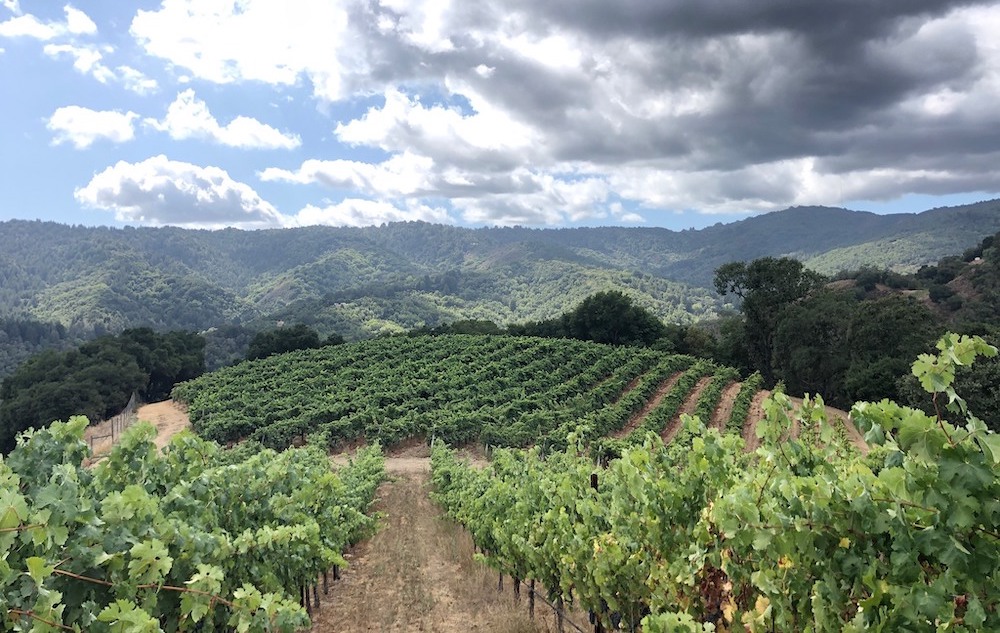
October 22, 2021 – Sandar & Hem is a relatively new winery and the passion play of Rob Bergstrom and his wife Recha, a Santa Cruz native.
Recognizing the fabulous sources of Chardonnay and Pinot Noir grapes here in the Santa Cruz Mountains, the couple currently make more than half a dozen Chardonnays—most of them vineyard designates, including from Bald Mountain, Bruzzone, Frances J, Le Boeuf and Mindego Ridge—as well as a Pinot Noir and Cabernet.
Rob named the wine brand after his ancestral family home place in Norway (Sandar) and surname (Hem). He makes the wine at a shared winery facility in San Francisco on Treasure Island, in a former steam plant, offering tastings there by appointment only. They are actively looking for a tasting room closer to where they live in Portola Valley, and are even considering moving the winery operation somewhere within the Santa Cruz Mountains AVA, if they could find the right setup.
Sandar & Hem will debut its wines as part of the Santa Cruz Mountains Vintner’s Festival this weekend at Cantine Wine Pub in Aptos, where you can taste and purchase their wines. They will be pouring 2020 Bates Ranch Rosé, 2019 Frances J. Chardonnay, 2019 Mindego Ridge Pinot Noir and 2018 Bates Ranch Cabernet. To secure your Vintner’s Festival tickets, and make reservations, go to: VFest
Recha has been instrumental in the inspiration, launch, and continued day-to-day operations of Sandar & Hem. She runs much of the finance and some marketing activities of the winery and is an equal partner for many of important winery business decisions. They truly went down this rabbit hole together!

We caught up with Rob to find out more about this “rabbit hole” project and where the inspiration for pursuing winemaking from our region originated.
What was the first Santa Cruz Mountains Chardonnay you tasted that made you want to explore winemaking from this region?
Memorable Chardonnays that made me want to learn more about the region include young wine from Mount Eden Estate, a 90s bottling of Ridge Chardonnay, 20+ years old at the time of drinking and a 60 year-old bottle from Martin Ray. The two latter wines had aged beautifully and were stunning examples of how Chardonnay from the region are incredible and age-worthy.
But it was the Chardonnays of Rhys from Horseshoe and Alpine Vineyards that really opened my eyes and made me realize this was a world class place to produce Chardonnay, comparable to but distinct from white Burgundy, and it’s their own right a place where Chardonnay could hit incredible highs with stunning expressions.
Are you expanding your Pinot Noir program? You seem to be doing well score wise.
We love telling the story of Chardonnay and all its unique expressions across the yet-to-be-formalized subregions of the AVA. We believe that our intense focus on Chardonnay makes us distinctive as a winery in the Santa Cruz Mountains. That said, I love crafting Pinot Noir, and we quickly sold out of the two Pinot Noirs we made in our first harvest , which was 2018. Those wines were released in 2020. For 2019, we made a Mindego Ridge Pinot Noir that will be released in a few weeks and we also made a tiny lot of 100% whole cluster Pinot Noir from a site that is primarily Chardonnay, the Frances J Vineyard (Aptos). That wine is very pretty, aromatic, and has that special silky texture that whole cluster can bring, but yields were far below expected with so little of that wine, a half barrel, that it will be a wine club exclusive.
For 2020, there was no Mindego Ridge Pinot Noir due to fires. For 2021, we have added a new Pinot Noir program from the Deerheart Vineyard near San Gregorio. (Ed note: Scott Sisemore of Waxwing has made wine from this vineyard in the past.)
How did you find Le Boeuf? What makes it unique?
We found Le Boeuf through a family friend of Taylor Smith who was helping us out with early marketing activity with the winery. The vineyard owner, visionary, and caretaker Burney Le Boeuf, a well known UC Santa Cruz Professor Emeritus, planted the site in 1974 with heritage clone Chardonnay on St. George rootstock. It is gently sloped on decomposed granite, dry farmed (no irrigation lines!), and surrounded by the stunning towering redwoods of Wilder Ranch State Park, just a few miles from the ocean. We befriended Burney, had the opportunity to taste many vintages of Chardonnay and could immediately taste the character of the site in every single vintage (mineral character, acid structure, orange oil aromatics) despite them being made with simple home winemaking equipment. This unique combination of characteristics along with the great opportunity to farm it ourselves, and improve the site with improved practices (organics, no pesticide, new heritage clone material) was incredibly appealing to us even though we realize such a low yielding site may never break even, it is one of the most satisfying things we have done.
How do you select the vineyard sources that you chose to work with?
We look to a large number of factors as we seek out vineyards in the SCM. They include history of planting on the site, geology, microclimate, plant material, current viticulture practices, great folks caring for the vineyard, and in general whether wines made from grapes from a site will make a wine of distinction that is delicious, truly reflects the site, and helps to tell the story of the Santa Cruz as we explore all the various “subregions.”

History: We look at sites that have a great history of yielding great wines. This might include sites/areas that both have a long continuous history of yielding great wines (e.g. Peter Martin Ray on Mount Eden) have been historic or famous in the past might be lesser known now for fine wine (e.g., Mountain winery/Paul Masson La Cresta Vineyard). We are passionate about finding and tasting wines both old and new from sites across the Santa Cruz Mountains, and through our tasting group have really been able to taste the incredible and consistent site characters of some of the great vineyards in the region. Bates Ranch is example of a site that you can see the greatness and consistent character of the wines over 5 decades. That said about history, we increasingly look to “frontier” sites in the region that push the envelope on the edges of the AVA. For example, this year we added Deerheart Vineyard, a stunning Pinot Noir Vineyard near San Gregorio, which is on the very edge of the band of where Pinot Noir might be thought to easily grow, even with the progression of climate change with warmer temperatures. We are also looking at sites near Pescadero and other regions on the very edge of the AVA.
Geology: We look for sites with distinct geology that are not too fertile with soils that may make the vines work to give wines of distinction. For example, we have vineyards on steep Purisma Shale (Mindego Ridge), Franciscan Shale (Peter Martin Ray), decomposed granite (Le Boeuf), and white Zayante sands (Bald Mountain).
Microclimate: In general, we prefer sites that are on the cooler side for a given variety and with a big diurnal shift, as they often give vibrant expressions with the great structure and acidity that the SCM AVA is known for. The majority of our sites, especially for Pinot Noir and Chardonnay, are very close to the ocean, or if they are not, have microclimates that are greatly influenced by altitude and the ocean.
Plant Material: We love sites that have significant vine age and use distinctive plant material that yield wines of character. For example, Le Boeuf was planted in 1974 on St. George Rootstock and we have rebudded half of it over to heritage clones to “reset” in response to intense Eutypa. Both Mindego Ridge and Deerheart Vineyard have the very rare clone 943 with tiny berries and intense color and flavor. Bald Mountain is own rooted, and Peter Martin Ray is planted to Mt Eden cuttings originating from La Questa vineyard in Woodside (which was planted with wood from Chateau Margaux).
Viticulture Practices: We strongly prefer organically farmed sites or sites that use zero herbicide and only use synthetics as a very last resort. We farm Le Boeuf with zero herbicide using cover crops and mechanical weeding, and only use organic spray (plant oils such as stylet and lupine extract and sulphur). The biggest impact we can have is moving into a vineyard that is not using these practices and working with the vineyard owners to move to organic.
Great Viticulturalists and Vineyard Managers: We love working with experienced vineyard folks who are passionate about the Santa Cruz Mountains, high wine quality, and organic practices. We work with the fantastic Prudy Fox and Ken Swegles at several of our sites – both fully dedicated to the region and true viticultural excellence.
Which vineyards did you get fruit from in 2020? 2021?
In 2020, we did not take grapes from many planned programs, and may declassify some programs, due to the tough vintage. However, we did purchase grapes in 2020 from:
Mountain Winery – Chardonnay
Bruzzone Vineyard – Chardonnay
Le Boeuf Vineyard – Chardonnay
Bates Ranch – Cabernet Sauvignon and Grenache
Peter Martin Ray Vineyard – Cabernet Sauvignon
In 2021 we purchased grapes from:
Mountain Winery – Chardonnay
Le Boeuf Vineyard – Chardonnay
Bald Mountain – Chardonnay
Mindego Ridge Vineyard – Pinot Noir
Deerheart Vineyard – Pinot Noir
Bates Ranch – Cabernet Sauvignon and Grenache (for Rosé)
Peter Martin Ray Vineyard – Cabernet Sauvignon
How many cases did you make for 2019? 2020?
In 2019 we made about 650 cases, and while we have not yet released anything but Rosé from the 2020 vintage to date, (most our wines are or will be released 2-4 years after harvest), we expect 250-400 cases.
About the author
Laura Ness is a longtime wine journalist, columnist and judge who contributes regularly to Edible Monterey Bay, Spirited, WineOh.Tv, Los Gatos Magazine and Wine Industry Network, and a variety of consumer publications. Her passion is telling stories about the intriguing characters who inhabit the fascinating world of wine and food.
- Laura Nesshttps://www.ediblemontereybay.com/author/lness/
- Laura Nesshttps://www.ediblemontereybay.com/author/lness/
- Laura Nesshttps://www.ediblemontereybay.com/author/lness/
- Laura Nesshttps://www.ediblemontereybay.com/author/lness/


